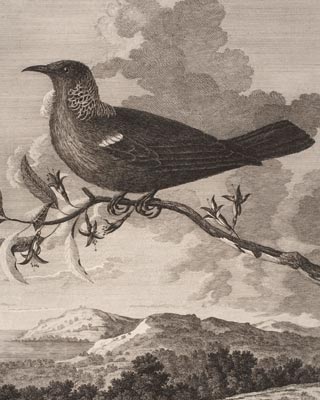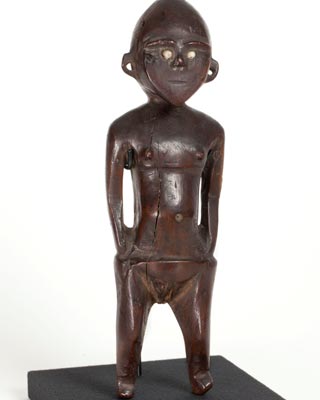At the time of Cook’s voyages, anthropology as a discipline did not exist. It was not until much later that the social and cultural life of people was considered worthy of serious study. The publication of Cook’s diaries and other texts pertaining to the exploration of the Pacific profoundly altered European attitudes, especially towards the peoples of the South Seas. One can imagine the sense of excitement caused throughout Europe when Cook returned, not unlike a modern astronaut, but from an even longer and lonelier journey. He brought back with him tales of ‘new discovered’ lands and objects made by people in the most remote islands on Earth.

From Captain Cook to Paradise
Captain James Cook never saw this depiction of the New Zealand Poe (Tui) bird in print. In July 1776 he set out on what would prove to be his third and final voyage, an expedition that culminated in his death in Hawaii in 1779. Cook landed at Ship Cove in Queen Charlotte Sound twelve days after this first edition, of an account of his second voyage to the Pacific (1772-1775), was published in London. It is one of the many items relating to Cook’s three Pacific voyages which now reside in the University of Canterbury collection and helps to reconstruct early European exploration of New Zealand and the Pacific region.

'Poe Bird' or Tui
James Cook, A Voyage Towards the South Pole and Round the World: Performed in His Majesty’s ships the Resolution and Adventure, in the years 1772, 1773, 1774, and 1775, 2 vols (London: Printed for W Strahan & T Cadell, 1777)
University of Canterbury Library

Tongan carved female figure with projecting pierced ears and inlaid beads of shells for eyes
Canterbury Museum, E149.652
Even in the nineteenth century the islands of the South Seas remained shrouded in a romantic mystique that idealised a ‘primitive’ lifestyle in a utopian paradise inhabited by ‘noble savages’. Following the arrival of missionaries in Tonga, many traditional religious artefacts were destroyed. Originally female figures such as this were placed as objects of veneration in traditional temples. Indigenous religious imagery was subjected to acts of sacrilege or destruction by Tongan chiefs as an over-zealous response during their conversion to Christianity. Contemporary records clearly indicate that missionaries sanctioned and condoned this desecration.